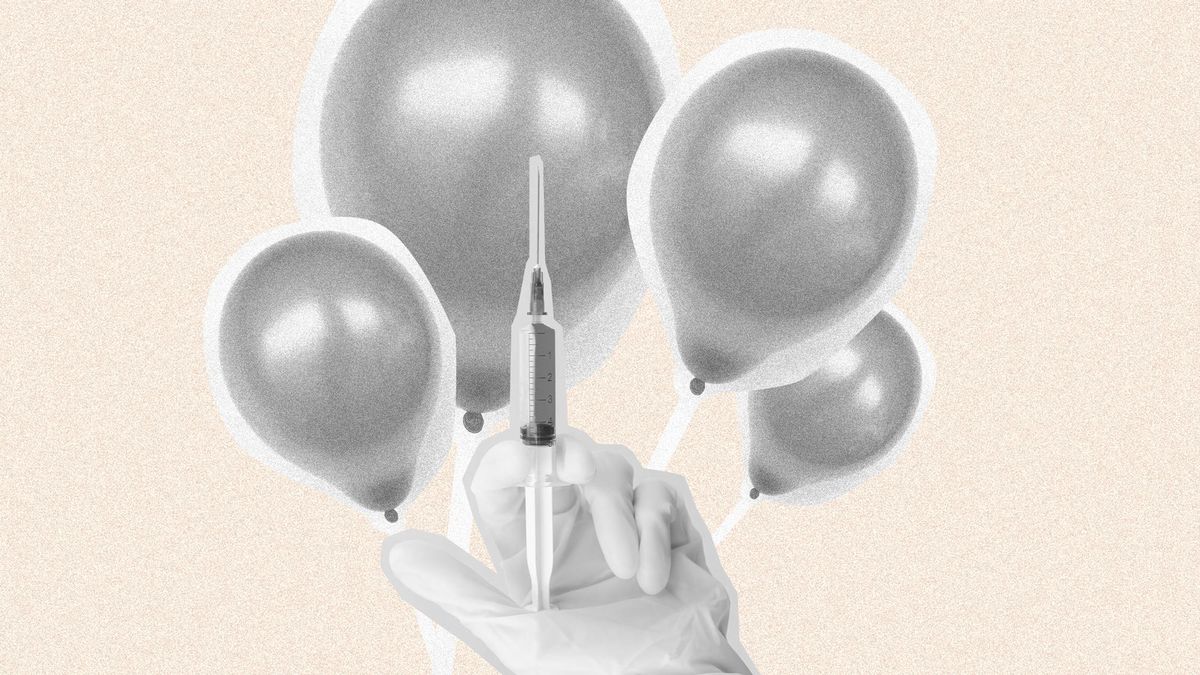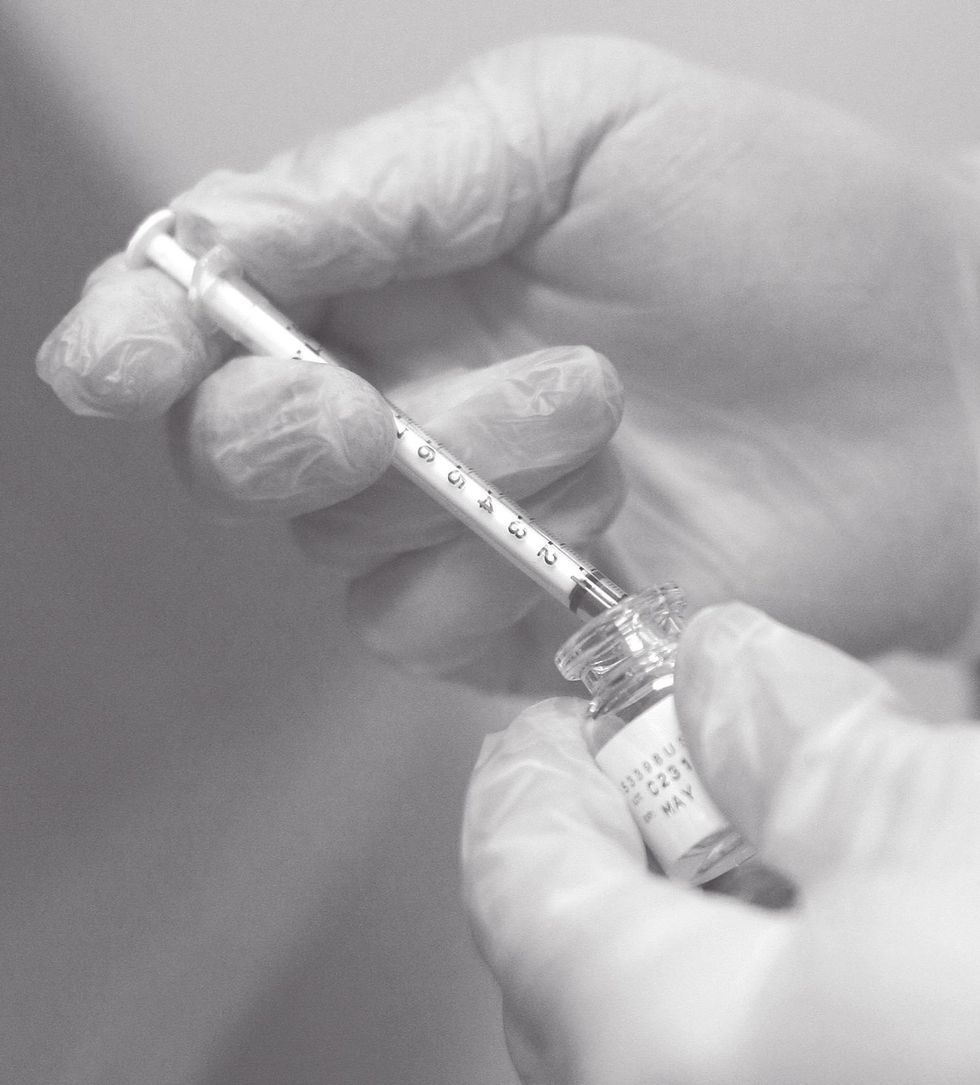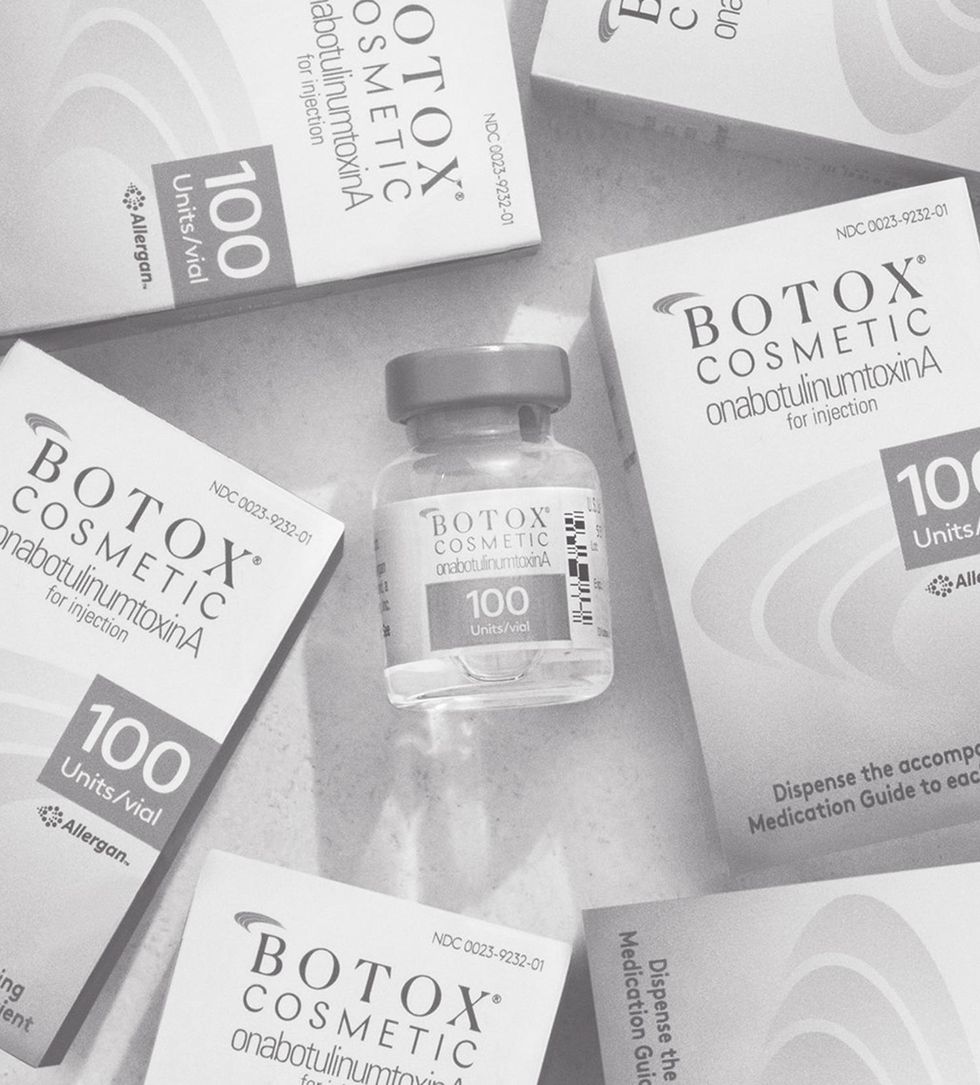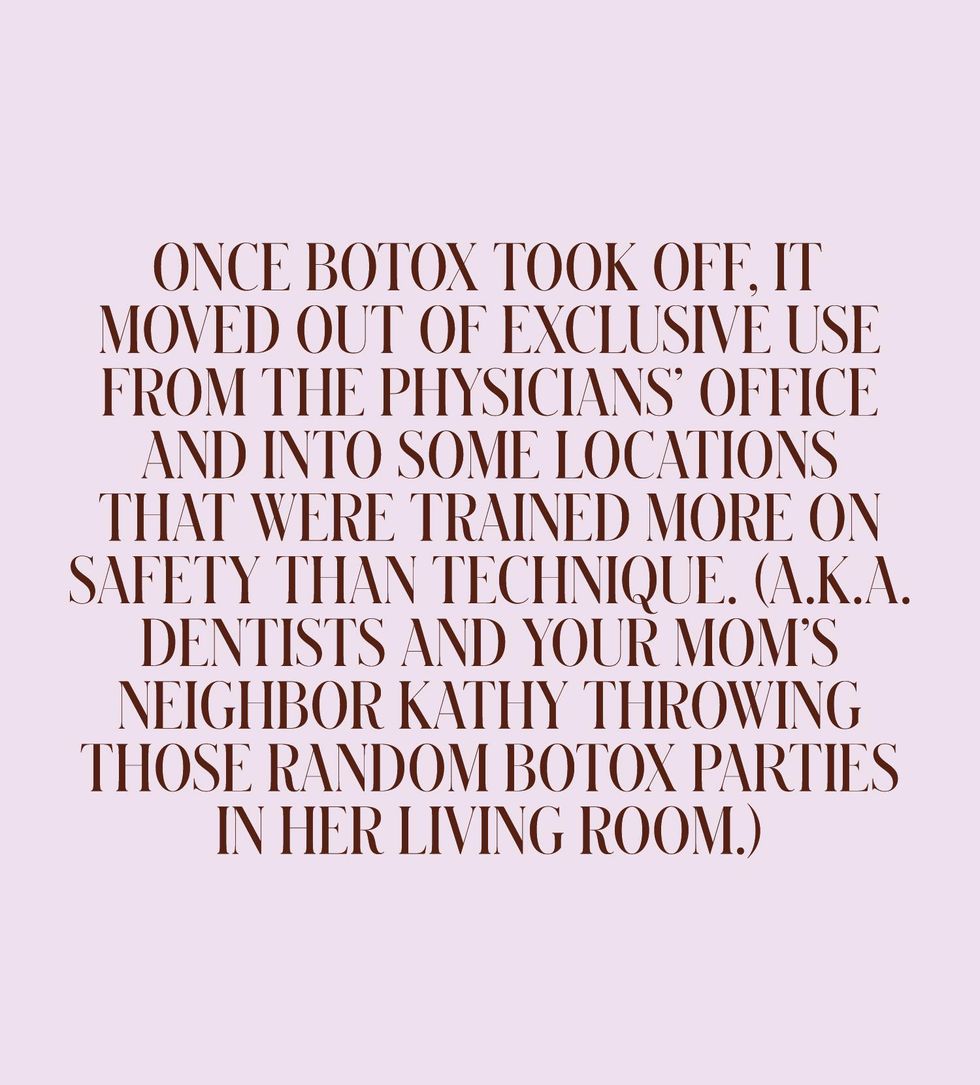How an Injectable Neurotoxin Changed the Face of Aging
Happy 20th birthday, Botox! You don't look a day over 19.

Dr. Mitchell Brin was working at the Neurological Institute at Columbia University in New York when he used an injectable muscle paralytic called Oculinum on patients with muscle spasms. He'd just finished up treating a patient with blepharospasm (involuntary muscle spasms of the eye), when they pointed out a side effect—the frown lines between their brows were softer. They wanted more.
In that moment, Dr. Brin inadvertently became one of the very first doctors to witness the aesthetic benefit of what we now know as Botox.
Twenty years ago, the thought of injecting substances into our faces to slow the effects of time was a concept that seemed straight out of a sci-fi movie (or a horror, depending on who you asked). But in the late '90s and early aughts, the neurotoxin formerly known as Oculinum was just hitting the scene under its new name, Botox, and being furtively whispered about by women of a certain age as a covert secret to wipe away wrinkles and turn back the clock on aging. Over the next two decades, Botox would shape the course of what we know as cosmetic dermatology, opening up a new treatment category that soon included facial fillers, lip injections, and even fat melters.
"When Botox came around, we all knew this was going to be something big."
The story of Botox Cosmetic is perhaps one of the most stranger-than-fiction tales to ever come out of the beauty industry—and yes, we're counting snail slime in that category. Botox (scientifically known as botulinum toxin) is a purified neurotoxin complex derived from a bacterium known as clostridium botulinum, a toxin that was first discovered way back in the 19th century in improperly canned or fermented food. It's considered one of the most deadly substances in the world due to its ability to induce suffocation by paralyzing the muscles used for breathing. This lethal quality is also what makes it such an incredible anti-aging treatment.
In 2002 Botox was granted FDA approval as the first aesthetic treatment for moderate to severe frown lines. More clinical trials followed, and in 2013 it received approval for treatment of crow's-feet, while 2017 saw FDA approval for forehead lines. There are countless "off-label" uses (i.e., considered medically safe but have not yet been given full FDA approval), and the company is constantly conducting clinical testing to get those uses the official thumbs-up from the FDA. (They won't specify which ones quite yet.)
For dermatologists and plastic surgeons, Botox started gaining traction well before it reached the masses. "I went to the very first lecture that was given on Botox back in 1991, and to hear that it would address wrinkles was very exciting to me," says Dr. Patricia Wexler, a board-certified dermatologist specializing in dermatology and dermatologic surgery in New York. "Prior to Botox, there was one type of filler available that was made from collagen—Zyderm and Zyplast. But they were fleeting in duration, and the bruising from it lasted for quite a few days. When we first started Botox at my practice, we were told at the time that it had to be diluted and it had to be used right away to keep its potency. So I started doing it one day a week at first—Botox Wednesday. But very quickly it had to become Botox Monday and Wednesday, and then Botox Monday, Wednesday, and Friday, until finally it was Botox every day."
Dr. Bruce Katz, a board-certified dermatologist and founder of Juva Skin and Laser Center in New York, was first introduced to Botox by the "Mother of Botox"—Dr. Jean Carruthers. "I was at a [dermatology] meeting in the mid-'90s with Dr. Jean Carruthers where she was telling me about this new product that she was injecting into people's foreheads to take away wrinkles, and I immediately wanted to know more," he says. "We had a few of my staff members who wanted to try it, and back then we were using an electromyogram, which is an electrical device that measures nerve conduction. We would use the device to find the nerve that would control the corrugator muscles that control the frown lines, and then we would inject the Botox."
Many doctors were so impressed with what they were hearing, they wanted to try it on themselves. "I was a resident in dermatology in 1997, and botulinum toxin was being used experimentally and off-label for wrinkles—it was kind of a hush-hush thing that wealthy people did, that not so many people had access to," says Dr. Paul Jarrod Frank, a celebrity cosmetic dermatologist and founder of PFRANKMD in New York. "We [as dermatologists] were playing with it, and I volunteered myself to treat my forehead. This is a treatment that now takes about 30 seconds to do, but back then it took 30 minutes because of all the precautions."
"When Botox came around, we all knew this was going to be something big," says Dr. Doris Day, a board-certified dermatologist in New York, who recalls sitting around with her fellow dermatology residents and injecting Botox into each other's faces to experience it for themselves. "We were like a surfer where you just catch the wave at the right time and you can really ride that wave beautifully. That's what it was like being the early injector of all these products—we got to ride that wave every time a new product came to market." Adds Dr. Sarmela Sunder, a double-board-certified plastic surgeon in Beverly Hills, "There really was never anything like it before. It is rare in a career or lifetime to see such a game-changing treatment.


"I would show patients before-and-after photos of the dramatic results because I knew that would convince them right away, and that's exactly what happened."
But in those early days, there was still some (understandable) trepidation from people concerned about Botox's toxic nature. After seeing the results on his staff, Dr. Katz immediately began to offer it to his patients, but it wasn't an instant slam dunk for his practice. "At first, people were rather hesitant—no one had heard about it before, and they were a little concerned because it was from botulinum toxin," he says. "So I would show patients before-and-after photos of the dramatic results because I knew that would convince them right away, and that's exactly what happened. They couldn't believe that the difference in the frown lines was from one injection. After they saw the photos, it wasn't that difficult to convince them to try it."
While word of mouth was helpful, according to Dr. Wexler, what really set things in motion for Botox's meteoric rise was when the press got wind of it and began writing articles and filming news segments. "I had ABC's 20/20 come to me for an interview when they heard about Botox. They stayed in my office all day and saw me inject it. Then they interviewed each patient as they were being injected, and they were all so enthusiastic about it," she said. This was followed by multi-page features in magazines like Allure back in 1994, which led to a greater visibility and awareness for Botox almost a full decade before it even gained FDA approval for cosmetic use.
Patients soon began asking for Botox by name, and they weren't the only ones. "In addition to people coming in for surgery consultation, they were also coming in asking for Botox," says Dr. David Shafer, a board-certified plastic surgeon and founder of Shafer Clinic Fifth Avenue in NYC, who also works as a master trainer for Botox, teaching doctors around the world on proper injection techniques. "I knew that when I built my plastic surgery business that I needed to build in a foundation of Botox. It's not only a very effective treatment, but also kind of a gateway into the plastic surgery world for patients."
Soon plastic surgeons and dermatologists across the country were offering Botox treatments to patients, many of whom had never gone to see a dermatologist before. The initial hesitation had mostly fallen by the wayside as Botox entered the public discourse, with people being more impressed with its one-shot wrinkle-erasing powers than concerned about its toxic origin story. "It was only physicians doing it initially, and if you trust your doctor and they tell you they have a treatment that they believe is safe and effective [for reducing wrinkles], most people were like, 'Cool, this is awesome. No wrinkles—sign me up!'" says Dr. Day.
"Now we are seeing patients in their 20s coming in for Botox...The gender gap is closing as well."
That's not to say there weren't some slip-ups in those early days. Once Botox took off, it moved out of exclusive use from the physician's office and into some locations that were trained more on safety than technique (aka dentists and your mom's neighbor Kathy throwing those random Botox parties in her living room). Then there was the Y2K babyfication of women and sexualization of youth—see: Britney Spears, Baby Spice, Bratz Dolls, those disturbing Steve Madden ads featuring models with distorted babydoll heads—that led to the telltale (and oft-ridiculed) "frozen" look. Celebrities like Nicole Kidman, Courteney Cox, and Cameron Diaz were pointed to as "overly Botoxed," and a backlash began of those in the public eye denying their (very obvious) Botox use and even some casting directors and studios admonishing or refusing to hire actors and actresses that went overboard due to their inability to make a full range of facial expressions.
Those darker days moved injectors to learn how to better control dosing and become more strategic in their injections. "When we first started using [Botox], it was all about removing the movement entirely. We measured success by how 'frozen' someone was," says Dr. Day. "Unfortunately, some injectors and patients still use that standard, but those of us who have been studying aesthetics for decades have learned that it's so much more than that. I understand that by softening one movement, I can strengthen the opposing movement.'"
"You've got to really intimately understand the drug and the molecule and the dosing before you can become creative," says Dr. Michelle Henry, a board-certified dermatologist in New York. "I learned it in a very academic, by-the-books way, which allows me to have a comfort level to color outside of the lines, so to speak. I can fine-tune it based on [each patient's] specific needs."
"I was told when I started doing it at the age of 27 that if and when it got approved, it would only be for older people, because younger people didn't need it," recalls Dr. Frank. "[But we've seen] that it helps people age better, and obviously we're seeing a lot more of a cultural younger usage of it." Adds Dr. Sunder, "When I first started injecting Botox, it was a much more mature female population, generally in their 60s and 70s. Now we are seeing patients in their 20s coming in for Botox. The gender gap is closing as well, with many more male patients seeking out treatment with each passing year."

Photo: Courtesy of Instagram/@botoxcosmetic

"Botox was about making you look younger, but now it's about making you look better."
There's also those creative uses Dr. Henry spoke of earlier, including popular off-label treatments that have nothing to do with forehead wrinkles. "We're actually using it to modify the structure and function of the face and other parts of the body," says Dr. Shafer. "One of the off-label uses is injecting it into the masseter muscle, which is in the lower part of the jawline. It helps you relax those muscles, which also helps thin the face, so we're changing the shape." Botox can also be used for what Dr. Shafer calls a functional structural change, where it's injected into the sides of the mouth to relax the downward-pulling muscles that can cause someone to have a naturally angry or sad look.
Perhaps one of the most impressive feats of Botox is the larger impact it's had on our cultural discourse around beauty and aging. What was once whispered about and passionately denied by celebrities when accused of using it is now proudly documented, injection by injection, on social media. "In the last 30 years, the biggest change that we have seen is the social acceptance of Botox," says Dr. Frank.
Part of that can be attributed to how doctors have adapted their technique over the years. "Much of what has allowed us to accept Botox as a routine treatment definitely has to do with our perception of the results," says Dr. Sunder. "The Botox of 2021 is much more artful, subtle, and natural-looking compared to the Botox of the 1990s, so it's more palatable to the consumer." Or, as Dr. Shafer so succinctly puts it, "Botox was about making you look younger, but now it's about making you look better."
For its part, Allergan and AbbVie (the company that acquired Botox last year) recognized the shift in perception and moved away from using models and celebrities to promote their products, instead looking to real people with personal stories about why they decided to try Botox as part of their new branding. "With [our new] See Yourself campaign, we are highlighting the voices of real patients who chose to discuss their treatment with Botox Cosmetic," says Carrie Strom, senior vice president of AbbVie and president of Global Allergan Aesthetics. "The more people share their stories and talk about their aesthetic treatments, the more we remove any remaining stigma and encourage further conversation. Social media has opened the door, and when you're able to share experiences, education on the science, and show outcomes, people feel comfortable learning more and trying it for themselves."
"[We'll see more] Botox to slim the face, Botox to lean out the neck, and Botox to create more feminine shoulder outlines."
As Botox approaches its 20th birthday as an aesthetic treatment, suffice it to say it's been a whirlwind two decades. So the question on everyone's mind is, where do we go from here? The injectables category as a whole has exploded since Botox's arrival, with new iterations cropping up what feels like every year—the latest, Qwo, is an FDA-approved injectable for the reduction of cellulite in the buttocks. The injectable that's closest on the horizon, according to Dr. Katz, is called DaxibotulinumtoxinA, a longer-lasting neuromodulator made by Revans that is said to be approaching FDA approval soon. "It does the same thing that regular Botox and other neuromodulators do, but lasts probably 30 percent longer, so it will be a market changer for sure," he says. Meaning instead of three to four months, you'll have a smooth, wrinkle-free visage for six to eight months.
While Allergan played coy, many of our derm sources mentioned that a faster-acting, shorter-duration version (aka "party Botox") that takes effect in 24 hours and only lasts four to six weeks is also imminent. For those that are new to Botox or working with a new injector for the first time, a shorter-acting Botox could be a smart option to help determine if they like the outcome and technique before committing. It can also work well for those who want to get treated before an event and don't have the standard three to seven days to wait for traditional Botox to take effect.
Another on-the-horizon innovation, according to Dr. Shafer and Dr. Katz, is needleless Botox that can be applied topically by a physician to achieve comparable results to injectable neuromodulators. Don't get too excited, though—both doctors think we've got a few years before that particular treatment becomes a reality.
Dr. Wexler and Dr. Katz think the next frontier for injectables will be in the category of skin tightening, something that currently is only achievable with radiofrequency and ultrasound devices like Thermage, Ultherapy, and Vivace. "It would be an injectable that replaces damaged collagen with fresh, new collagen to tighten skin," says Dr. Katz. "There are chemicals out there that do that, and it's about getting the right dilutions and quantities to inject so that you get the maximal tightening effect. It's an area that's being studied as we speak, and if it's successful, it's going to be huge."
While there's not anything in the works that he's aware of, Dr. Shafer thinks that a hybrid injectable that combines multiple treatments could theoretically be a product that an existing company develops down the line. He gives the example of a hyaluronic filler that provides instant plumping combined with a filler that stimulates the body's own production of collagen over time.
For Dr. Frank, he believes the future of injectables is rooted less in technological innovation and more in the advancements in application. "This is a treatment that will be performed on the same person for decades to come, and based on their age, skin type, and what we're treating, we need to have appropriate restraint," he says. "We want to make sure that people not only look better in the now, but see how we're going to help them age in a natural-looking way in the future. It is a long game now, not a short game."
As for Dr. Sunder, she believes that the near future of Botox includes a more mainstream use of those off-label indications. "[We'll see more] Botox to slim the face, Botox to lean out the neck, and Botox to create more feminine shoulder outlines."
To say that nobody saw Botox coming is the understatement of the century. "Botox Cosmetic has really changed the course of aesthetic medicine as we know it, and it's so fascinating that it wasn't at all the original intention of it," says Dr. Brin. "When discussion around the potential aesthetic use of the product started, there was some skepticism in the medical community. Now, more than 20 years later, Botox Cosmetic has become much more impactful than originally thought." Not too shabby for something that started out as a deadly toxin linked to incorrectly packaged food.
Want more stories like this?
What I Wish I Knew Before Getting Botox
Here's Who You Can Trust to Do Your Botox
I Got Botox Injected Into My Jaw—Here's Why




